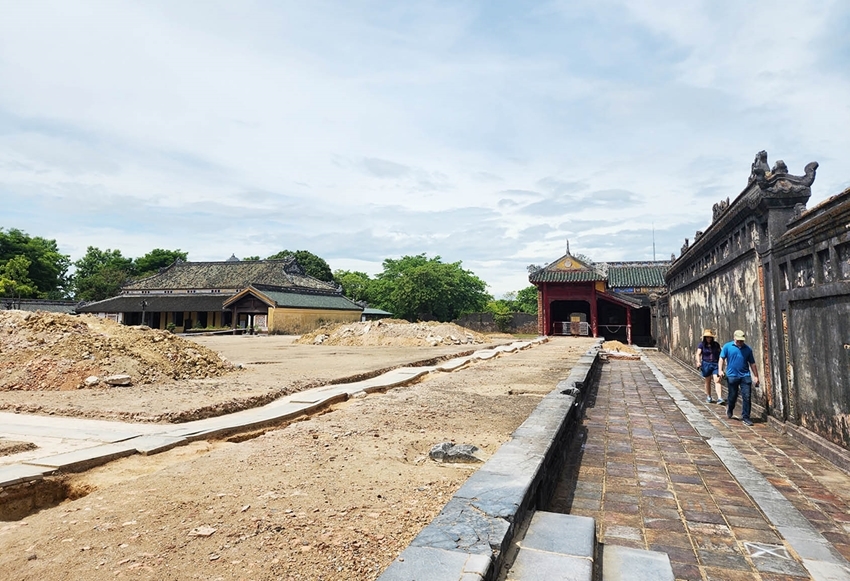 |
| According to experts, restoring Can Chanh Hall should be done in two stages |
Sufficient scientific and legal bases
Before that, the project of restoring Can Chanh Hall had been approved by the 8th Thua Thien Hue Provincial People's Committee (term 2021 - 2026) with a budget of nearly VND200 billion, implemented in 4 years. In July 2023, the Vietnam National Museum of History collaborated with HMCC to carry out the archeological work of Can Chanh Hall to supplement important scientific data for drawing up a plan to restore this 220-year-old relic.
According to historical documents, Can Chanh Hall was built in the 3rd year of Gia Long’s era (1804.) It had been repaired 20 times to different degrees until it was completely destroyed in 1947 with only the foundation left. It was among the constructions located on the Shinto axis of Hue Imperial City along with Ngo Mon (Noon Gate), Dien Thai Hoa (Hall of Supreme Harmony), Dai Cung Mon (Great Golden Gate), Dien Can Thanh (Can Thanh Hall), Cung Khon Thai (Khon Thai Hall), Dien Kien Trung (Kien Trung Palace.)
In the Nguyen's era, Can Chanh Hall was the place where the king held Court Meetings on the 5th, the 10th, the 20th and the 25th of each lunar month. That was also the place where foreign ambassadors were received and royal banquets were held.
According to Mr. Hoang Viet Trung, Director of Hue Monuments Conservation Center, researches on Can Chanh Hall began tens of years ago with the participation of experts both in and out of the country. During that time, the Center has studied and collected lots of precious documents about and photos of this construction. “Luckily, historical documents and photos of Can Chanh Hall are abundant. The other constructions of the same time and the result of the archeological work are also accurate scientific data for the implementation of the restoration of Can Chanh Hall,” said Trung.
According to Mr. Ho Huu Hanh, Director of Hue Relic Repair Joint Stock Company, the research stage has been completed, and there have been sufficient scientific and legal bases to implement the project of restoring this important hall of the Hue Ancient Capital relic complex.
Suitable time
According to many experts and researchers, the project of restoring Can Chanh Hall needs to be done as soon as possible.
“The restoration needs to be done carefully and should be divided into two stages. The first stage focuses on restoring the entire construction architecturally and the second one restores the interior with decorative patterns and the remaining items. This is also the most proper time to restore Can Chanh Hall since we have accumulated lots of valuable experience in restoring monuments over the years. “If we don't do it right away, it will push the project further and we’ll encounter greater difficulties,” said Prof. Hoang Dao Kinh.
According to Mr. Nguyen Xuan Hoa, a researcher of Hue history and culture, the geometric method used to determine the height of the building is quite accurate with the result proved. But it is necessary to compare and contrast with the current status quo to confirm the reliability of the method.
Dr. Phan Thanh Hai, Director of the Department of Culture and Sports, comments the relationship between Hall of Supreme Harmony and Can Chanh Hall in terms of size and structure based on the experience of building traditional constructions. He also proposes planning to promote the value of the construction after restoration.
According to Mr. Tran Thanh Binh, a researcher of history and culture, it is necessary to supplement studies on the decorative patterns on the boxes and the roofs as well as the furniture, the glass paintings, etc.
According to Mr. Ho Huu Hanh, the restoration of Can Chanh Hall will include strengthening the foundation, making the most of the original materials, restoring the tiled floor as it was in Thanh Thai’s era (1988), restoring decorative patterns in Khai Dinh’s era, building the protective walls with curved tiles and three-element mortar, restoring the colors following the colors of the similar constructions based on the comparison with documentary photos taken in Khai Dinh’s era. The roof will be restored with tube-tiles, yellow flat tiles and traditional decorative patterns. The entire wooden frame will be lacquered and gilded with gold and the two wings in the east and the west will be lacquered and gilded with silver.